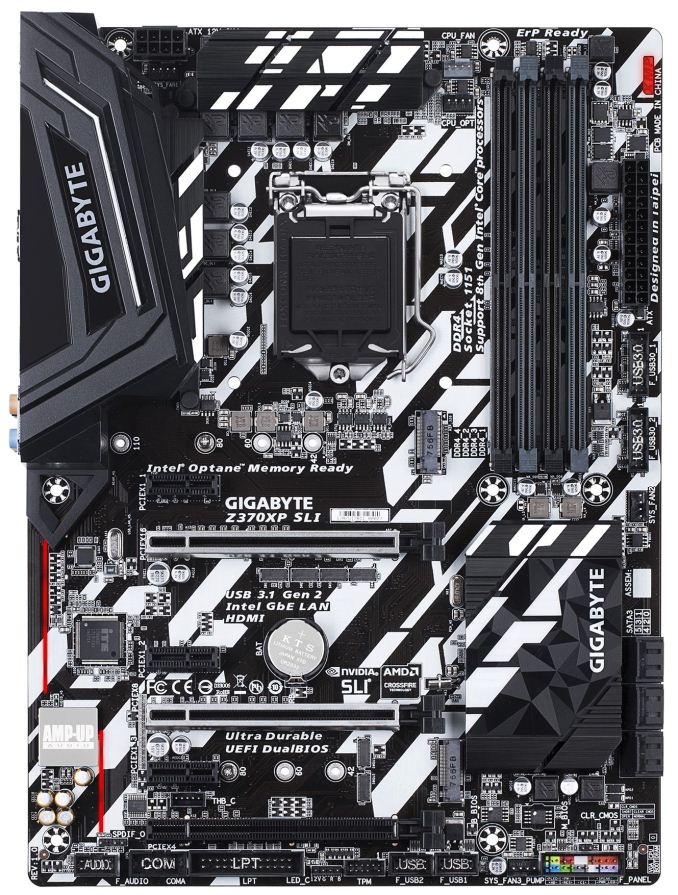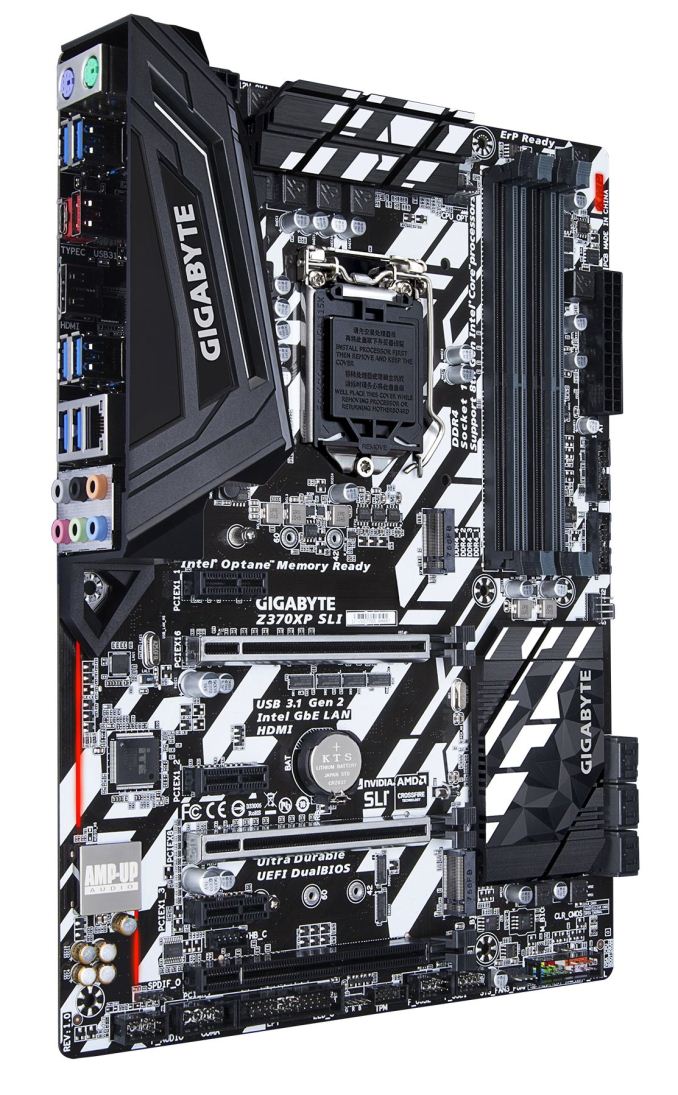Analyzing Z370 for Intel's 8th Generation Coffee Lake: A Quick Look at 50+ Motherboards
by Ian Cutress, Anton Shilov, Joe Shields & Gavin Bonshor on October 20, 2017 2:00 PM ESTGIGABYTE Z370XP SLI
The Z370XP SLI is not part of the Gaming line of motherboards from GIGABYTE, but part of its Ultra Durable series. The basic features of the Z370 platform can be found on the board, but fewer bells and whistles are included with one major exception, SLI (as given in the name).
One of the first things one may notice is a lack of RGB LEDs most anywhere on the board. The only places where we can find non-standard LED implementations are for the audio separation line and the XMP LED up the upper right-hand corner. As a drop down from higher up models, the memory slots are not reinforced, but two of the full-length PCIe lanes do have the reinforcement. There is a rear IO shroud present, covering only the back panel area while leaving the audio parts unprotected. The Z370XP SLI matches the Ultra Gaming in phase count, and by having two M.2 slots. In essence, this comes out as a simplified, non-RGB version of the Ultra gaming.
Clearly, the aesthetic has changed on the Z370XP SLI. It has the same black PCB color, however, the AORUS Falcon stenciling is gone and replaced by a bright white, with more prominent markings taking a wide path from the bottom in the audio section, through the PCIe area, socket and DIMMs covering most of the board. The VRM heatsinks and shroud are different, although the same IO shroud has been used from the other mid-range or lower boards in the product stack. The Ultra Gaming uses RGB LEDs under the shroud, while the XP SLI does not. The PCH is also styled a bit differently compared to the other boards in this lineup.
Like the other Z370 boards, the Z370XP SLI supports a total of 64GB RAM. The PCIe connector configuration is the same as the other boards with three full-length slots and three PCIe 1x slots. The first two full-length CPU connected PCIe slots (x16 or x8/x8) have the steel reinforcement so common on many boards but removes the RGB LEDs we have seen on other implementations in order to keep costs down. There are two RGB LED headers on the board, one of which can perform RGBW. The board supports two-way SLI and three-way Crossfire.
Moving on to storage, the Z370XP SLI has six SATA ports driven by the chipset, and there are two M.2 slots available; one supporting 110mm drives, the other 80mm. Both do not come with heat spreaders. Regarding fan headers, the board has a total of five scattered around the board with all being hybrid headers with the ability to be PWM or voltage controlled. Audio processing is handled by the Realtek ALC1220 codec and has EMI shielding on the IC itself. The network side of things is handled by a single Intel NIC, likely an Intel i219V, with ESD and Surge protection.
USB 3.1 (10 Gbps) is supported by the ASMedia 3142 controller and has a USB Type-C port as well as a Type-A port on the back panel. Six USB 3.1 (5 Gbps) ports are found on the back panel as well, while the remaining four USB 2.0 ports are available through internal USB headers. Display output from the CPUs integrated graphics is handled by a single HDMI port. Rounding out connectivity on the rear IO are two PS/2 ports, the Intel NIC, and the audio stack.
| GIGABYTE Z370XP SLI | |
| Warranty Period | 3 Years |
| Product Page | Link |
| Price | Amazon US |
| Size | ATX |
| CPU Interface | LGA1151 |
| Chipset | Intel Z370 Express |
| Memory Slots (DDR4) | Four DDR4 Supporting 64GB Dual Channel Support DDR4 4133+ |
| Network Connectivity | 1 x Intel GbE LAN |
| Onboard Audio | Realtek ALC1220 |
| PCIe Slots for Graphics (from CPU) | 1 x PCIe 3.0 x16 slots @ x16 1 x PCIe 3.0 x16 slots @ x8 |
| PCIe Slots for Other (from Chipset) | 1 x PCIe 3.0 x16 slots @ x4 3 x PCIe 3.0 x1 slots @ x1 |
| Onboard SATA | 6 x Supporting RAID 0/1/5/10 |
| Onboard SATA Express | None |
| Onboard M.2 | 2 x PCIe 3.0 x4 - NVMe or SATA |
| Onboard U.2 | None |
| USB 3.1 (10 Gbps) | 1 x Type-C (ASMedia) 1 x Type-A (ASMedia) 4 x Rear Panel |
| USB 3.1 (5 Gbps) | 6 x Rear Panel |
| USB 2.0 | 4 x Headers (Chipset) |
| Power Connectors | 1 x 24-pin EATX 1 x 8-pin ATX 12V |
| Fan Headers | 1 x CPU 1 x Watercooling CPU 2 x System Fan headers 1 x System Fan/ Water Pump header |
| IO Panel | 1 x PS/2.2 keyboard port 1 x PS/2 mouse port 1 x HDMI Port 6 x USB 3.1 ports 1 x USB 3.1 Type-C 1 x USB 3.1 Type-A 1 x RJ-45 LAN Port 6 x Audio Jacks |













83 Comments
View All Comments
sor - Friday, October 20, 2017 - link
Damn. At least key it differently and call it LGA1151v2 or something.The changes are so minimal it really does seem like planned obsolescence. Does it really need more power pins to support new chips with the same power envelopes? Really? They couldn’t handle that on the CPU PCB?
KaarlisK - Saturday, October 21, 2017 - link
Actually it is ~1.5 times peak current with the same average power envelope, so yes, they need the change.If they had not brought the launch forward and just launched together with the cheap chipsets, there would be far less complaints.
sor - Saturday, October 21, 2017 - link
Where did you find information indicating current has increased 50%? I just spent about ten minutes trying to find a reference backing that up, perhaps something indicating the 8 series operates at a much lower voltage within same TDP, which would translate to higher current but they seem to operate in the same 1.2-1.3v range.You’re not just assuming they draw more current because they have two more cores, are you?
KaarlisK - Sunday, October 22, 2017 - link
Notice the difference between average and peak.And the information is in publicly available documents. I did not bother to look it up, but others have, for example: https://forum.beyond3d.com/threads/intel-coffee-la...
Crono - Saturday, October 21, 2017 - link
Nice roundup. That's a lot of motherboards to spec and summarize. I especially appreciate the handy chart at the end, it's a good, quick-and-dirty comparison tool.Landcross - Saturday, October 21, 2017 - link
You guys forgot 2 new Z370 boards from Supermicro :)https://motherboarddb.com/motherboards/?chipset=19...
Xpl1c1t - Sunday, October 22, 2017 - link
The mITX board looks incredible.+ Low ESR Tantalum capacitors! (first time seeing them on VRM duty on a mainboard)
+ HDMI 2.0
+ 2x M.2 Slots
+ USB 3.1 Type C
+ Optical SPDIF
- RGB.......
MadAd - Saturday, October 21, 2017 - link
Great write up but for me its just another depressing generation of oversized, overpriced ATX form factor offerings on which the vast majority of users wont even plug a second gpu into, with the smaller and more size appropriate FF represented as a minority afterthought.With all the progress of PCs since the 90s whod have thought that I could still use the same ATX case today while every single other component (from floppy drives to 2d Mattrox cards) have long gone to the recyclers. I find it so annoying how manufacturers have stuck on this prehistoric gargantuan case size with the other sizes being an afterthought. It feels like like stifled innovation while everything else is moving on.
rocky12345 - Saturday, October 21, 2017 - link
Great article and a lot of work put in to get it out for us to read thank you.My only issue is and it is nit your fault is why these companies feel the need to totally blanket the market with basically the same boards just a different model number and basically a few tiny changes and spray paint it a different color and use the word gaming and put something x or x1 or k,k3 etc etc. For crap sakes just release three models not 7-10 models of the same crap it is pretty much just greed I guess.
The whole market is like this now with anything computer related of and if it has the words GAMING or RGB in it's got to be good for sure. My fav is that gaming mouse pad next it will have RGB lighting in it...lol
CitizenZer0 - Wednesday, October 25, 2017 - link
Agreed